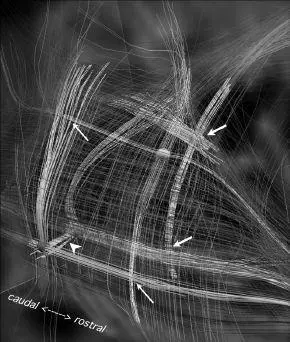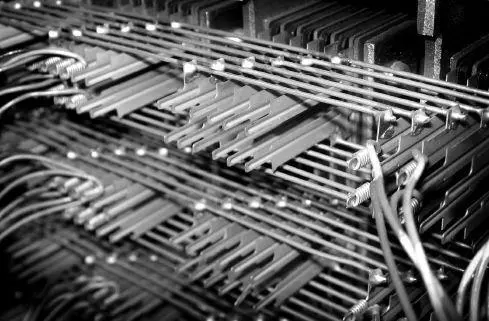There is a type of electronic chip called a field programmable gate array (FPGA) that is based on a similar principle. The chip contains millions of modules that implement logic functions along with connections-in-waiting. At the time of use, these connections are either activated or deactivated (through electronic signals) to implement a particular capability.
In the neocortex, those long-distance connections that are not used are eventually pruned away, which is one reason why adapting a nearby region of the neocortex to compensate for one that has become damaged is not quite as effective as using the original region. According to the Wedeen study, the initial connections are extremely orderly and repetitive, just like the modules themselves, and their grid pattern is used to “guide connectivity” in the neocortex. This pattern was found in all of the primate and human brains studied and was evident across the neocortex, from regions that dealt with early sensory patterns up to higher-level emotions. Wedeen’s Science journal article concluded that the “grid structure of cerebral pathways was pervasive, coherent, and continuous with the three principal axes of development.” This again speaks to a common algorithm across all neocortical functions.
It has long been known that at least certain regions of the neocortex are hierarchical. The best-studied region is the visual cortex, which is separated into areas known as V1, V2, and MT (also known as V5). As we advance to higher areas in this region (“higher” in the sense of conceptual processing, not physically, as the neocortex is always just one pattern recognizer thick), the properties that can be recognized become more abstract. V1 recognizes very basic edges and primitive shapes. V2 can recognize contours, the disparity of images presented by each of the eyes, spatial orientation, and whether or not a portion of the image is part of an object or the background. 6 Higher-level regions of the neocortex recognize concepts such as the identity of objects and faces and their movement. It has also long been known that communication through this hierarchy is both upward and downward, and that signals can be both excitatory and inhibitory. MIT neuroscientist Tomaso Poggio (born in 1947) has extensively studied vision in the human brain, and his research for the last thirty-five years has been instrumental in establishing hierarchical learning and pattern recognition in the “early” (lowest conceptual) levels of the visual neocortex. 7

The highly regular grid structure of initial connections in the neocortex found in a National Institutes of Health study.

Another view of the regular grid structure of neocortical connections.

The grid structure found in the neocortex is remarkably similar to what is called crossbar switching, which is used in integrated circuits and circuit boards.
Our understanding of the lower hierarchical levels of the visual neocortex is consistent with the PRTM I described in the previous chapter, and observation of the hierarchical nature of neocortical processing has recently extended far beyond these levels. University of Texas neurobiology professor Daniel J. Felleman and his colleagues traced the “hierarchical organization of the cerebral cortex…[in] 25 neocortical areas,” which included both visual areas and higher-level areas that combine patterns from multiple senses. What they found as they went up the neocortical hierarchy was that the processing of patterns became more abstract, comprised larger spatial areas, and involved longer time periods. With every connection they found communication both up and down the hierarchy. 8
Recent research allows us to substantially broaden these observations to regions well beyond the visual cortex and even to the association areas, which combine inputs from multiple senses. A study published in 2008 by Princeton psychology professor Uri Hasson and his colleagues demonstrates that the phenomena observed in the visual cortex occur across a wide variety of neocortical areas: “It is well established that neurons along the visual cortical pathways have increasingly larger spatial receptive fields. This is a basic organizing principle of the visual system…. Real-world events occur not only over extended regions of space, but also over extended periods of time. We therefore hypothesized that a hierarchy analogous to that found for spatial receptive field sizes should also exist for the temporal response characteristics of different brain regions.” This is exactly what they found, which enabled them to conclude that “similar to the known cortical hierarchy of spatial receptive fields, there is a hierarchy of progressively longer temporal receptive windows in the human brain.” 9
The most powerful argument for the universality of processing in the neocortex is the pervasive evidence of plasticity (not just learning but interchangeability): In other words, one region is able to do the work of other regions, implying a common algorithm across the entire neocortex. A great deal of neuroscience research has been focused on identifying which regions of the neocortex are responsible for which types of patterns. The classical technique for determining this has been to take advantage of brain damage from injury or stroke and to correlate lost functionality with specific damaged regions. So, for example, when we notice that someone with newly acquired damage to the fusiform gyrus region suddenly has difficulty recognizing faces but is still able to identify people from their voices and language patterns, we can hypothesize that this region has something to do with face recognition. The underlying assumption has been that each of these regions is designed to recognize and process a particular type of pattern. Particular physical regions have become associated with particular types of patterns, because under normal circumstances that is how the information happens to flow. But when that normal flow of information is disrupted for any reason, another region of the neocortex is able to step in and take over.
Plasticity has been widely noted by neurologists, who observed that patients with brain damage from an injury or a stroke can relearn the same skills in another area of the neocortex. Perhaps the most dramatic example of plasticity is a 2011 study by American neuroscientist Marina Bedny and her colleagues on what happens to the visual cortex of congenitally blind people. The common wisdom has been that the early layers of the visual cortex, such as V1 and V2, inherently deal with very low-level patterns (such as edges and curves), whereas the frontal cortex (that evolutionarily new region of the cortex that we have in our uniquely large foreheads) inherently deals with the far more complex and subtle patterns of language and other abstract concepts. But as Bedny and her colleagues found, “Humans are thought to have evolved brain regions in the left frontal and temporal cortex that are uniquely capable of language processing. However, congenitally blind individuals also activate the visual cortex in some verbal tasks. We provide evidence that this visual cortex activity in fact reflects language processing. We find that in congenitally blind individuals, the left visual cortex behaves similarly to classic language regions…. We conclude that brain regions that are thought to have evolved for vision can take on language processing as a result of early experience.” 10
Читать дальше















